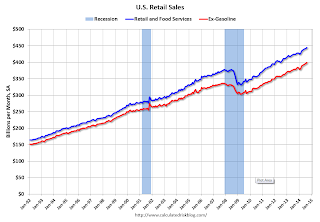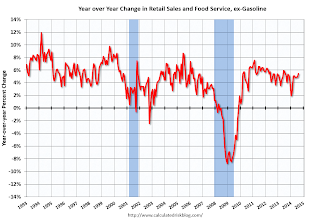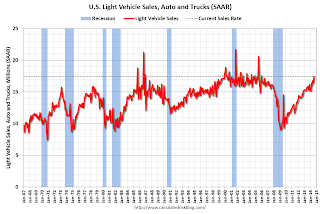by Calculated Risk on 9/12/2014 09:55:00 AM
Friday, September 12, 2014
Preliminary September Consumer Sentiment increases to 84.6
Click on graph for larger image.
The preliminary Reuters / University of Michigan consumer sentiment index for September was at 84.6, up from 82.5 in August.
This was above the consensus forecast of 83.1. Sentiment has generally been improving following the recession - with plenty of ups and downs - and a big spike down when Congress threatened to "not pay the bills" in 2011.
Retail Sales increased 0.6% in August
by Calculated Risk on 9/12/2014 08:41:00 AM
On a monthly basis, retail sales increased 0.6% from July to August (seasonally adjusted), and sales were up 5.0% from August 2013. Sales in July were revised up to a 0.3% increase from unchanged. Sales in June were also revised up.
From the Census Bureau report:
The U.S. Census Bureau announced today that advance estimates of U.S. retail and food services sales for August, adjusted for seasonal variation and holiday and trading-day differences, but not for price changes, were $444.4 billion, an increase of 0.6 percent from the previous month, and 5.0 percent (±0.9%) above August 2013. ... The June to July 2014 percent change was revised from virtually unchanged to 0.3 percent.
 Click on graph for larger image.
Click on graph for larger image.This graph shows retail sales since 1992. This is monthly retail sales and food service, seasonally adjusted (total and ex-gasoline).
Retail sales ex-autos were up 0.3%.
The second graph shows the year-over-year change in retail sales and food service (ex-gasoline) since 1993.
 Retail sales ex-gasoline increased by 5.5% on a YoY basis (5.0% for all retail sales).
Retail sales ex-gasoline increased by 5.5% on a YoY basis (5.0% for all retail sales).The increase in August was above consensus expectations of a 0.4% increase.
Including the upward revisions to June and July, this was a strong report.
Thursday, September 11, 2014
Friday: Retail Sales
by Calculated Risk on 9/11/2014 07:43:00 PM
First, from Merrill Lynch:
We have revised up our forecast for 3Q GDP growth to 3.5% from 3.0% and 2Q tracking has moved up to 4.8%, from 4.0%.Some of this is a bounce back from the -2.1% decline in Q1 GDP (on a seasonally adjusted annual rate basis, SAAR).
Friday:
• At 8:30 AM ET, Retail sales for August will be released. The consensus is for retail sales to increase 0.4% in August, and to increase 0.3% ex-autos.
• At 9:55 AM, the Reuter's/University of Michigan's Consumer sentiment index (preliminary for September). The consensus is for a reading of 83.1, up from 82.5 in August.
• Also at 10:00 AM, Manufacturing and Trade: Inventories and Sales (business inventories) report for July. The consensus is for a 0.5% increase in inventories.
DataQuick: Home Sales slow in SoCal and Bay Area
by Calculated Risk on 9/11/2014 04:32:00 PM
From DataQuick: Southland Home Sales Sputter; Median Sale Price Hits 80-Month High
A total of 18,796 new and resale houses and condos sold in Los Angeles, Riverside, San Diego, Ventura, San Bernardino and Orange counties last month. That was down 7.7 percent from 20,369 sales in July, and down 18.5 percent from 23,057 sales in August 2013, according to CoreLogic DataQuick data. ...From DataQuick: Bay Area Home Sales Slow in August; Prices Increases Ease Back
...
Foreclosure resales – homes foreclosed on in the prior 12 months – represented 5.0 percent of the Southland resale market last month. That was down from 5.2 percent the prior month and down from 7.0 percent a year earlier. In recent months the foreclosure resale rate has been the lowest since early 2007. In the current cycle, foreclosure resales hit a high of 56.7 percent in February 2009.
Short sales – transactions where the sale price fell short of what was owed on the property – made up an estimated 5.9 percent of Southland resales last month. That was up slightly from 5.8 percent the prior month and down from 11.5 percent a year earlier.
Absentee buyers – mostly investors and some second-home purchasers – bought 23.5 percent of the Southland homes sold last month. That tied the July level as the lowest absentee share since December 2010, when 23.4 percent of homes sold to absentee buyers. Last month’s figure was down from 26.7 percent a year earlier. The peak was 32.4 percent in January 2013, while the monthly average since 2000, when the CoreLogic DataQuick absentee data begin, is about 19 percent.
emphasis added
A total of 7,578 new and resale houses and condos sold in the nine-county Bay Area last month. That was down 10.6 percent from 8,474 in July and down 12.0 percent from 8,616 in August last year, according to CoreLogic DataQuick data. ...A few key year-over-year trends: 1) declining distressed sales (about half as many this year as in August 2013), 2) generally declining investor buying, and 3) declining total sales. For August, it looks like non-distressed sales were also down significantly.
...
Last month foreclosure resales – homes that had been foreclosed on in the prior 12 months – accounted for 2.9 percent of resales, up from 2.7 percent the month before, and down from 4.3 percent a year ago. Foreclosure resales in the Bay Area peaked at 52.0 percent in February 2009, while the monthly average over the past 17 years is 9.8 percent, CoreLogic DataQuick reported.
Short sales – transactions where the sale price fell short of what was owed on the property – made up an estimated 3.8 percent of Bay Area resales last month. That was down from an estimated 4.0 percent in July and down from 7.6 percent a year earlier.
Last month absentee buyers – mostly investors – purchased 18.4 percent of all Bay Area homes. That was down from a revised 18.9 percent the prior month, and down from 20.3 percent a year earlier.
emphasis added
Hotels: Occupancy up 4.5%, RevPAR up 10.6% Year-over-Year
by Calculated Risk on 9/11/2014 01:55:00 PM
From HotelNewsNow.com: STR: US results for week ending 6 September
The U.S. hotel industry recorded positive results in the three key performance measurements during the week of 31 August through 6 September 2014, according to data from STR.Note: ADR: Average Daily Rate, RevPAR: Revenue per Available Room.
In year-over-year measurements, the industry’s occupancy rate rose 4.5 percent to 59.0 percent. Average daily rate increased 5.9 percent to finish the week at US$108.87. Revenue per available room for the week was up 10.6 percent to finish at US$64.20.
emphasis added
The following graph shows the seasonal pattern for the hotel occupancy rate using the four week average.
There is always a dip in occupancy after the summer (less leisure travel), and business travel should pick up soon.
 Click on graph for larger image.
Click on graph for larger image.The red line is for 2014, blue is the median, and black is for 2009 - the worst year since the Great Depression for hotels. Purple is for 2000.
The 4-week average of the occupancy rate is solidly above the median for 2000-2007, and is at about the level as for the same week in 2000 (the previous high).
Right now it looks like 2014 will be the best year since 2000 for hotels. Since it takes some time to plan and build hotels, I expect 2015 will be a record year for hotel occupancy. Note: Smith Travel analysts say that supply growth will pickup next year, but remain relatively slow, "hotel supply growth in the United States is forecast to be 1% this year and 1.3% in 2015".
Data Source: Smith Travel Research, Courtesy of HotelNewsNow.com
Goldman Sachs Revises Q2 GDP estimate to 4.7%
by Calculated Risk on 9/11/2014 12:05:00 PM
From Brett LoGiurato at Business Insider: Goldman Is Now Saying That Q2 GDP Growth Was Absolutely Massive
Goldman Sachs revised its estimate of second-quarter GDP growth to 4.7% on Thursday, based on new data from the Census Bureau's Quarterly Services Survey (QSS).Here is the Q2 Quarterly Services Press Release
Stronger-than-expected healthcare spending growth led to the revised Goldman estimate of 4.7%, which was up 0.5% from the Bureau of Economic Analysis' second advance-estimate of 4.2%.
Health care and social assistance The estimate of U.S. health care and social assistance revenue for the second quarter of 2014, not adjusted for seasonal variation, or price changes, was $565.6 billion, an increase of 3.0 percent (± 0.9%) from the first quarter of 2014 and up 3.7 percent (± 0.9%) from the second quarter of 2013. The fourth quarter of 2013 to first quarter of 2014 percent change was not revised from -2.0 percent (± 0.8%).The third estimate of Q2 GDP will be released on Friday, September 26th. Some of the Q2 GDP increase was a bounce back from the weather impacted Q1.
Weekly Initial Unemployment Claims increase to 315,000
by Calculated Risk on 9/11/2014 08:35:00 AM
The DOL reports:
In the week ending September 6, the advance figure for seasonally adjusted initial claims was 315,000, an increase of 11,000 from the previous week's revised level. The previous week's level was revised up by 2,000 from 302,000 to 304,000. The 4-week moving average was 304,000, an increase of 750 from the previous week's revised average. The previous week's average was revised up by 500 from 302,750 to 303,250.The previous week was revised up to 304,000.
There were no special factors impacting this week's initial claims.
The following graph shows the 4-week moving average of weekly claims since January 1971.
 Click on graph for larger image.
Click on graph for larger image.The dashed line on the graph is the current 4-week average. The four-week average of weekly unemployment claims increased to 304,000.
This was above the consensus forecast of 300,000 and in the normal range for an economic expansion.
Wednesday, September 10, 2014
Thursday: Unemployment Claims, Quarterly Services Report
by Calculated Risk on 9/10/2014 07:01:00 PM
This is an important change ... from the WSJ: Cost of Employer Health Coverage Shows Muted Growth
The cost of employer health coverage continued its muted growth this year with a 3% increase that pushed the average annual premium for a family plan to $16,834, according to a major survey.Thursday:
The increase was slightly less than the 4% seen last year, according to the annual poll of employers performed by the nonprofit Kaiser Family Foundation along with the Health Research & Educational Trust, a nonprofit affiliated with the American Hospital Association. The share of the family-plan premium borne by employees was $4,823, or 29% of the total, the same percentage as last year.
The total annual cost of employer coverage for an individual was $6,025 in the 2014 survey, up 2%, a difference that wasn't statistically significant.
• At 8:30 AM ET, the initial weekly unemployment claims report will be released. The consensus is for claims to decrease to 300 thousand from 302 thousand.
• At 10:00 AM, the Q2 Quarterly Services Report from the Census Bureau.
• At 2:00 PM, the Monthly Treasury Budget Statement for August.
Vehicle Sales: Fleet Turnover Ratio
by Calculated Risk on 9/10/2014 02:29:00 PM
Back in early 2009, I wrote a couple of posts arguing there would be an increase in auto sales - Vehicle Sales (Jan 2009) and Looking for the Sun (Feb 2009). This was an out-of-the-consensus call and helped me call the bottom for the US economy in mid-2009.
Here is an update to the U.S. fleet turnover graph.
This graph shows the total number of registered vehicles in the U.S. divided by the sales rate through August 2014 - and gives a turnover ratio for the U.S. fleet (this doesn't tell you the age or the composition of the fleet). Note: the number of registered vehicles is estimated for 2012 through 2014.
The wild swings in 2009 were due to the "cash for clunkers" program.

The estimated ratio for August was just over 14 years - back to a more normal level.
Note: I argued the turnover ratio would "probably decline to 15 or so eventually" and that has happened.

The current sales rate is now near the top (excluding one month spikes) of the '98/'06 auto boom.
Light vehicle sales were at a 17.45 million seasonally adjusted annual rate (SAAR) in August.
I now expect vehicle sales to mostly move sideways over the next few years.
FNC: Residential Property Values increased 7.4% year-over-year in July
by Calculated Risk on 9/10/2014 10:58:00 AM
In addition to Case-Shiller, and CoreLogic, I'm also watching the FNC, Zillow and several other house price indexes.
FNC released their July index data today. FNC reported that their Residential Price Index™ (RPI) indicates that U.S. residential property values increased 0.6% from June to July (Composite 100 index, not seasonally adjusted). The other RPIs (10-MSA, 20-MSA, 30-MSA) increased between 0.4% and 0.6% in July. These indexes are not seasonally adjusted (NSA), and are for non-distressed home sales (excluding foreclosure auction sales, REO sales, and short sales).
The year-over-year (YoY) change slowed in July, with the 100-MSA composite up 7.4% compared to July 2013. For FNC, the YoY increase has been slowing since peaking in February at 9.4%.
The index is still down 19.5% from the peak in 2006.

This graph shows the year-over-year change based on the FNC index (four composites) through July 2014. The FNC indexes are hedonic price indexes using a blend of sold homes and real-time appraisals.
All of the price indexes are now showing a slowdown in price increases.
The July Case-Shiller index will be released on Tuesday, September 30th, and I expect Case-Shiller to show a further slowdown in YoY price increases.



